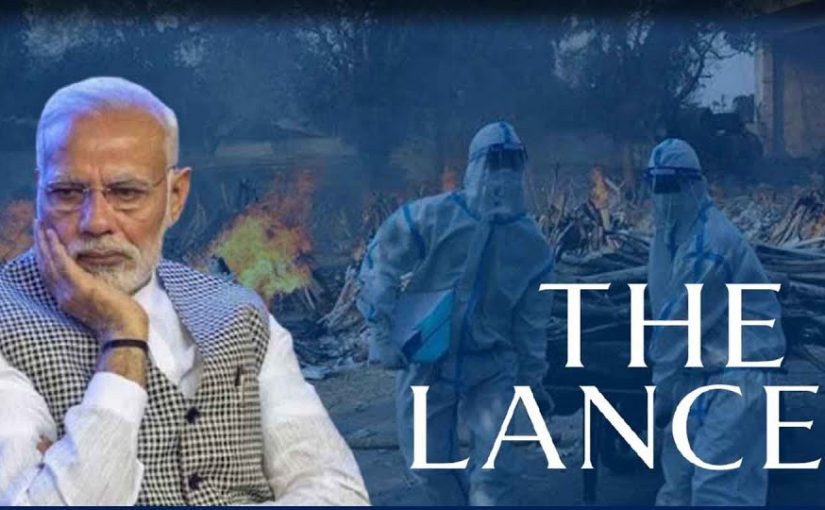REACTION: The last time the Lancet commented on covid management by the BJP government, Head of Department of Preventive Medicine Jagdish Kakodkar and other ‘saffron’ doctors demanded a ban on the journal, accusing it of interfering in the internal affairs of India
By Lancet Staff
The world’s most prestigious medical journal “LANCET” has once again condemned the Indian Chief Minister Narendra Modi for holding election rallies and mass religious events like the Kumbh Mela which triggered the deadly second wave in India. Both the UK and WHO have described the new double mutant coronavirus variant as of concern to the entire world, as it may trigger off a third wave. Already in the UK they have identified as many as 500 India-returned British citizens who are infected with the new variant.
The scenes of suffering in India are hard to comprehend. As of May 4, more than 20•2 million cases of COVID-19 had been reported, with a rolling average of 378 000 cases a day, together with more than 222 000 deaths, which experts believe are likely to be substantial underestimates. Hospitals are overwhelmed, and health workers are exhausted and becoming infected. Social media is full of desperate people (doctors and the public) seeking medical oxygen, hospital beds, and other necessities. Yet before the second wave of cases of COVID-19 began to mount in early March, Indian Minister of Health Harsh Vardhan declared that India was in the “endgame” of the epidemic. The impression from the government was that India had beaten COVID-19 after several months of low case counts, despite repeated warnings of the dangers of a second wave and the emergence of new strains. Modelling suggested falsely that India had reached herd immunity, encouraging complacency and insufficient preparation, but a serosurvey by the Indian Council of Medical Research in January suggested that only 21% of the population had antibodies against SARS-CoV-2. At times, Prime Minister Narendra Modi’s Government has seemed more intent on removing criticism on Twitter than trying to control the pandemic.
Despite warnings about the risks of superspreader events, the government allowed religious festivals to go ahead, drawing millions of people from around the country, along with huge political rallies—conspicuous for their lack of COVID-19 mitigation measures. The message that COVID-19 was essentially over also slowed the start of India’s COVID-19 vaccination campaign, which has vaccinated less than 2% of the population. At the federal level, India’s vaccination plan soon fell apart. The government abruptly shifted course without discussing the change in policy with states, expanding vaccination to everyone older than 18 years, draining supplies, and creating mass confusion and a market for vaccine doses in which states and hospital systems competed.
The crisis has not been equally distributed, with states such as Uttar Pradesh and Maharashtra unprepared for the sudden spike in cases, quickly running out of medical oxygen, hospital space, and overwhelming the capacity of cremation sites, and with some state governments threatening those asking for oxygen or a hospital bed with national security laws. Others, such as Kerala and Odisha, were better prepared, and have been able to produce enough medical oxygen in this second wave to export it to other states.
India must now pursue a two-pronged strategy. First, the botched vaccination campaign must be rationalised and implemented with all due speed. There are two immediate bottlenecks to overcome: increasing vaccine supply (some of which should come from abroad) and setting up a distribution campaign that can cover not just urban but also rural and poorer citizens, who constitute more than 65% of the population (over 800 million people) but face a desperate scarcity of public health and primary care facilities. The government must work with local and primary health-care centres that know their communities and create an equitable distribution system for the vaccine.
Second, India must reduce SARS-CoV-2 transmission as much as possible while the vaccine is rolled out. As cases continue to mount, the government must publish accurate data in a timely manner, and forthrightly explain to the public what is happening and what is needed to bend the epidemic curve, including the possibility of a new federal lockdown. Genome sequencing needs to be expanded to better track, understand, and control emerging and more transmissible SARS-CoV-2 variants. Local governments have begun taking disease-containment measures, but the federal government has an essential role in explaining to the public the necessity of masking, social distancing, halting mass gatherings, voluntary quarantine, and testing. Modi’s actions in attempting to stifle criticism and open discussion during the crisis are inexcusable.
The Institute for Health Metrics and Evaluation estimates that India will see a staggering 1 million deaths from COVID-19 by Aug 1. If that outcome were to happen, Modi’s Government would be responsible for presiding over a self-inflicted national catastrophe. India squandered its early successes in controlling COVID-19. Until April, the government’s COVID-19 taskforce had not met in months. The consequences of that decision are clear before us, and India must now restructure its response while the crisis rages. The success of that effort will depend on the government owning up to its mistakes, providing responsible leadership and transparency, and implementing a public health response that has science at its heart
Coutersy:www.thelancet.com

Oxygen and Vaccine, Where are you? I am coming from the Center. Why so much delay? Why it was not sent, when first phase was over? Because of this delayed, now so many people died!